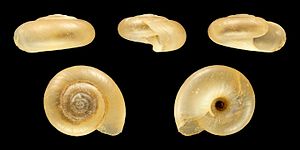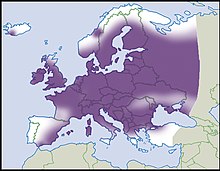Shiny dagger snail
| Shiny dagger snail | ||||||||||||
|---|---|---|---|---|---|---|---|---|---|---|---|---|

Shiny dagger snail ( Zonitoides nitidus ) |
||||||||||||
| Systematics | ||||||||||||
|
||||||||||||
| Scientific name | ||||||||||||
| Zonitoides nitidus | ||||||||||||
| ( OV Müller , 1774) |
The shiny dagger snail ( Zonitoides nitidus ) is a species of snail from the suborder of the land snail (Stylommatophora). The species, which occurs in large parts of Europe, has also been anthropogenic to North America.
features
The case is low-conical and right-hand wound. It measures 6 to 7 mm in diameter, with a height of up to 3.5 mm. It has 4.5 slightly arched whorls that are wide and regularly winding and slowly increasing. This creates a comparatively large navel (for a species of the snail family), it takes up about 20% of the width of the shell. The mouth, which is inclined to the axis of the winding, is slightly flattened-elliptical, cut at the top by the previous winding. The mouth edge is straight and tapered sharply.
The housing is red-brown to dark red-brown; outside strongly, irregularly striped and shiny. In living animals, the housing color is almost black, as the housing is translucent and appears much darker due to the blue-gray to almost black body of the animal. Shortly before the mouth, the orange-red mantle marginal gland shines through the shell.
In the hermaphroditic genitalia, the spermatic duct (vas deferens) enters the very short epiphallus . The penis is sub-cylindrical with a conical end piece inside, which is covered by a calcareous plate. The inner surface of the penis has smooth axial folds. The animals have a love arrow to stimulate their partner (name!), Who sits in an arrow sack. The arrow sack and penis are surrounded by a thin, transparent tissue cover. The penile retractor muscle attaches roughly in the middle of the penis. The free fallopian tube (oviduct) is long, occupied by the perivaginal gland. The spermathec has a long, thin stem that attaches between the penis and the free fallopian tube. An additional conductor connects the penis to this stem, and another conductor also connects to the vagina. The reservoir (bladder) almost reaches the albumin gland (protein gland).
Similar species
The British dagger snail ( Zonitoides excavatus ) is on average smaller and more tightly coiled with a wider navel. The glossy dagger snail also has a slightly larger mouth.
Geographical distribution and habitat
The species occurs throughout Europe with the exception of northern Scandinavia and northwestern Spain and Portugal. In the east the distribution area extends to Siberia, in the south to northwest Africa. It has also been carried off to North America and Iceland as well as New Zealand (and probably also to other regions). According to other studies, it has a Holarctic distribution. In Switzerland it rises to 2,100 m above sea level.
The species lives on wet meadows, reed belts of lakes and rivers, on swamps and in alluvial forests, mostly near water. It is extremely common in these habitats.
Way of life
The animals feed on rotting plant material, fungi and fresh herbaceous plants . Especially in summer, the glossy dagger snail attacks and eats other smaller snails, especially the small marsh snail ( Galba truncatula ) that occurs in its habitat . The eggs are laid from June to October. They are enclosed by a calcareous shell, somewhat flattened and measure one to 1.6 mm in diameter. Small clutches of 2 to 8 eggs are laid. A total of three to four such clutches are produced with a total of up to 30 eggs. The juvenile snails hatch after 21 to 27 days, depending on the temperature. You already have a housing with 1½ turns. On average, around one turn is formed per month. The animals that have reproduced usually die in late autumn. The animals hatched this year, the early hatched individuals can already have 4 to 4½ coils, overwinter. Smaller animals that have only formed two or three coils before hibernation usually hibernate a second time. As a rule, the animals live to be one year old, more rarely and in the case of a second hibernation also 15 to 16 months, very rarely they hibernate a second time.
Taxonomy
The taxon was set up in 1774 by the Danish naturalist Otto Friedrich Müller in the original combination Helix nitidus . It is the type species of the genus Zonitoides Lehmann, 1862. The taxon is generally recognized.
Some authors subdivide the genus Zonitoides into five sub-genera. In this classification, Zonitoides (Zonitoides) nitidus is also the type species of the nominate subgenus Zonitoides (Zonitoides) Lehmann, 1863.
Danger
The IUCN does not assess the stock situation . In Germany it is not considered endangered.
literature
- Klaus Bogon: Land snails biology, ecology, biotope protection. 404 p., Natur Verlag, Augsburg 1990, ISBN 3-89440-002-1 , p. 220/21.
- Michael P. Kerney, RAD Cameron & Jürgen H. Jungbluth: The land snails of Northern and Central Europe. 384 pp., Paul Parey, Hamburg & Berlin 1983, ISBN 3-490-17918-8 , pp.
- Adolf Riedel: Materials for the knowledge of the Palearctic Zonitidae (Gastropoda) . XII-XIV. Fragmenta Faunistica, 25 (9): 115-
Individual evidence
- ↑ Jürgen H. Jungbluth and Dietrich von Knorre: Trivial names of land and freshwater mollusks in Germany (Gastropoda et Bivalvia). Mollusca, 26 (1): 105-156, Dresden 2008 ISSN 1864-5127 , p. 122.
- ^ Alexandru V. Grossu: Gastropoda Romaniae 4 Ordo Stylommatophora Suprafam: Arionacea, Zonitacea, Ariophantacea şi Helicacea. 564 S., Bucharest 1983, pp. 90-92.
- ↑ a b Anatolij A. Schileyko: Treatise on Recent Terrestrial Pulmonate Molluscs Part 10 Ariophantidae, Ostracolethidae, Ryssotidae, Milacidae, Dyakiidae, Staffordiidae, Gastrodontidae, Zonitidae, Daudebardiidae, Parmacellidae. Ruthenica, Supplement 2 (10): 1307-1488, Moscow 2003 ISSN 0136-0027 , p. 1374.
- ↑ Evgeniy Shivkov: The penial stalk of the Zonitoides nitidus (OF Müller, 1774) (Gastropoda: Pulmonata: Gastrodontidae) spermathecal duct as an allosperm container. Folia Malacologica, 21 (3): 121-125, 2013 PDF
- ^ A b Francisco W. Welter Schultes: European non-marine molluscs, a guide for species identification = identification book for European land and freshwater mollusks. A1-A3 S., 679 S., Q1-Q78 S., Göttingen, Planet Poster Ed., 2012 ISBN 3-933922-75-5 , ISBN 978-3-933922-75-5 (p. 402)
- ↑ MB Seddon, DT Holyoak: Land gastropoda of NW. Africa. New distributional data and nomenclature. Journal of Conchology, 34: 311-323, 1993 abstract
- ↑ iNaturalist NZ: Zonitoides nitidus
- ^ Museum of New Zealand: Zonitoides nitidus (Müller, 1774)
- ^ Ewald Frömming: Biology of the Central European Landgastropods. 404 p., Duncker & Humblot, Berlin 1954, p. 105.
- ↑ Daniel Rondelaud: La predation de Lymnaea (Galba) truncatula Müller par Zonitoides nitidus Müller, moyen de lutte biologique. Annales de parasitologie humaine et comparée, 50 (1): 55-61, Paris 1975 PDF
- ↑ Elżbieta Kuźnik-Kowalska, Beata. M. Pokryszko: Age structure and growth rate of Zonitoides nitidus (OF Müller, 1774) (Gastropoda: Pulmonata: Gastrodontidae). Folia Malacologica, 19 (1): 51-53, 2011
- ↑ Otto Friedrich Müller: Vermium terrestrium et fluviatilium, seu animalium infusoriorum, helminthicorum, et testaceorum, non marinorum, succincta historia. Volume alterum. S. I-XXXVI (= 1-36), 1-214, Heineck & Faber, Havniae / Copenhagen & Lipsiae / Leipzig, 1774 Online at Biodiversity Heritage Library , p. 32.
- ↑ Animal Base: Zonitoides nitidus (Müller, 1774)
- ↑ Fauna Europaea
- ↑ MolluscaBase: Zonitoides nitidus (OV Müller, 1774)
- ^ Vollrath Wiese: The land snails of Germany. 352 pp., Quelle & Meyer, Wiebelsheim 2014, ISBN 978-3-494-01551-4 (p. 165)

